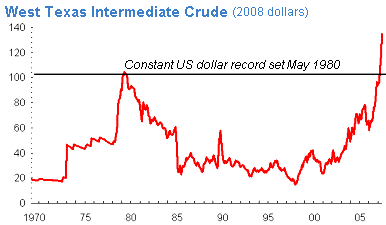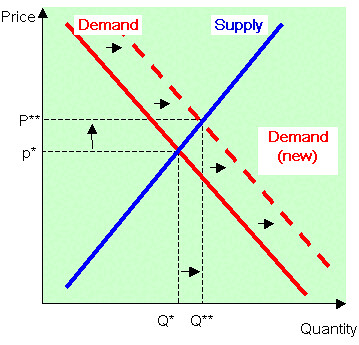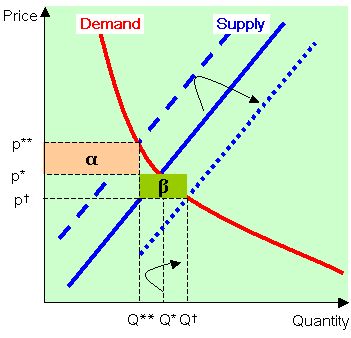Commodity Prices and Speculators
Figure 1 Source: International Monetary Fund WEO, Chapter 5 |
Figure 2 |
This post will deal with the question of whether or not speculative activity has played a role in the recent run-up of the price of oil. The null hypothesis* is that recent conditions are nothing more nefarious than the adjustment of prices to increasing demand. Rejecting the null hypothesis means we need to acknowledge that speculative activity on commodities markets has led to the recent increases (or contributed somewhat to the size).
SOME THEORY
I'm going to need to introduce some technical terms for explanation.
- pools: an asset for which the total tradable supply is either permanently limited (e.g., paintings by dead artists, real estate) or represents a share of the total (e.g., equities).
- flows: an asset that is produced and consumed at fairly high rates, such as oil, copper, wheat, or steel.
- tradable streams: an exotic type of tradable that includes electricity and pressurized natural gas (PNG). Markets in tradable streams are, at best, not mature and I won't be discussing them here.
- null hypothesis: In statistics, the negation of the idea one wants to test. When statistics is used to establish a particular finding of fact, there must be an explicit statement of fact that one is seeking to prove (the test hypothesis) and an explicit contradictory hypothesis (the null hypothesis) that one seeks to prove false.
- inventories: US inventories of crude oil are counted in two ways: commercial and commercial plus strategic petroleum reserves (SPR). The Department of Energy usually supplies statistics on both, but it's commercial inventories that get reported. The SPR is under Congressional control; usually Congress has an incentive to add to the SPR, rather than release reserves, so it should come as no surprise that the SPR is huge: almost 650 million bbls, or twice the commercial inventory. Recently, as prices hit staggering highs, Congress took the momentous decision to desist from further expansion of the SPR.
The Coleman-Levin report features a chart on p.19 that reveals the oscillation of private inventories (commercial US less SPR); inventories are shown mainly oscillating between 290 and 330 million bbl (i.e, over a range equal to 4 days worth of imports to the USA). - strike price; guaranteed price of a commodity at date that futures contract matures. Hence, a future contract for 100 bbl of WTI oil at $150/bbl for 6 months in the future (23 Nov '08), which is currently $18 above the price this exact minute.
- spot price is the actual quoted price of the commodity
Figure 3 |
Figure 4 |
But let's now introduce financial speculators. Suppose they know the demand curve is actually concave with respect to the origin (Figure 4). If one really big investor could carry it off, he could buy a huge amount of the stuff, hoard it somewhere, and then sell it. The price would go up a lot, which would make profit α, while the loss incurred selling the inventory on the world market would be the smaller amount β.
More realistically, speculators don't buy current flows, but future ones: say, oil in six months time. Now, there's no huge tank farms with sequestered inventory, but rather, a bubble in the price of oil to be delivered in December '08. The problem, of course, is that this is always possible; and as the price gets more and more out of line, demand shrivels. But producers of either refined gasoline products, or products that require energy to produce, aren't in a position to know that. So they plan based on the forwards market rather than the spot (or current) price. When Dec '08 arrives, other commodities have gone up in price because production of them really has gone down, in response to the soaring costs of inputs. Of course, the oil producers (Kuwait, Venezuela, etc.) have to adjust production of oil downward in response to the pancaking demand.
LIMITATIONS OF THE THEORYIn theory, speculators who buy commodities future or options (the forward markets) are betting against producers on the price at the time of delivery. Gordon Gecko thinks West Texas Intermediate Crude will be $200/barrel in December; Ellis Wyatt thinks it will be $150. By agreeing to pay Wyatt $175/barrel for oil delivered then, Gecko allows Wyatt to ramp up production to where marginal cost of recovery and shipping is $175/bbl. And if Gecko is right, he walks away with an enormous profit. If he's wrong, and oil is less than $175, then he's already paid for Wyatt's capital expansion; the losses would come out of previous successful bets he's made. The speculator, in theory, absorbs the risk of major short-run fluctuations in price.
But what the speculator can't do, at least in theory, is influence the outcome. Gecko can buy all the options in the world, bidding up the forward price to something astronomical: on the actual commodities markets, the flow of commodities into port facilities all over the world has to match the flow out of them, and the flow out will stop if processors and refiners can't afford them. Several news outlets have suggested that speculators contribute to the high price of petroleum, although without offering details as to how this is possible.
(Examples include Financial Times "Commodity prices part speculative - IMF"; Los Angeles Times, "Are commodity traders bidding up food, fuel prices?")
However, I had heard references to a US Senate Report entitled "The Role of Market Speculation in Rising Oil And Gas Prices" (link below), which alleged that the most plausible price for oil was well below $60/bbl.
Since late 2004, the amount of stored oil in the United States has been increasing. Oil inventories recently reached 347 million barrels – an eight-year high and the largest U.S. inventory since 1998, when oil was $15 per barrel. Similarly, oil inventories in Organisation for Economic Co-operation and Development (OECD) countries recently reached a 20-year high. As the report explains, the traditional factors of "supply and demand" do not tell the whole story on oil and gas prices.Bear in mind that that report was published in late 2006, when $60 billion was comparable to about one quarter's worth of US crude oil consumption. Since that report was published, crude oil inventories in the USA have declined somewhat to 320 million bbls. Inventories did indeed reach a high at the end of '06, but Department of Energy statistics show both US and OECD inventories have hovered around 2400-2700 million bbls since 1994 (EIA). And they've fallen off considerably since the late-'06 spike.
What is new, according to the Levin-Coleman report, is that over the past few years market speculators have poured tens of billions of dollars into the energy commodity markets. For example, the International Monetary Fund reports that over the past three years approximately $100-$120 billion has been invested in energy markets worldwide. Over this same period about $60 billion has been invested in oil futures on the NYMEX.
One major issue for Congressional investigators was the popularity of commodity indexed funds, which allowed small investors to buy stakes in the movements of commodities. As speculators bought futures in (say) WTI oil for delivery in December, the strike price would presumably soar (this ignores the fact that a booming futures market can include contracts with any strike price, and indeed does: complete listings include the prices for futures at many different prices, including above and below the spot price. Another consideration, though, is the impact of derivatives markets on inventories of the traded commodity: basically, if an index fund is pegged to the price of WTI oil, then the firm offering the fund is presumably obligated to own tangible inventories of the commodity equal to the amount notionally owned by investors buying into the fund.
(I am not aware that this is essential; a fund could instead invest in instruments intended to beat the judgment of amateur investors in no-load funds; in most quarters, the short-run liabilities for the fund would be smaller than quarterly net increases in asset values, and there would be no need to literally match what the investors actually did. So if I offer a fund whose value is indexed to WTI oil, then all I need to do is own financial instruments that match or exceed the growth in value of WTI oil. If there are many other funds offered by my firm, then the risk that I'll fail to do this is greatly mitigated by the fact that in quarters like this one, the losses from the WTI fund will be offset by net gains from the other funds.)
While the Senate report includes a lot of hyperventilating claims about speculation, there's surprisingly little (for a 60-page report) on actual mechanisms for "disconnecting" market equilibria and the price of petroleum. Essentially, everything is riding on a brief spike in oil inventories, and a rather smallish one at that.
There does exist a nontrivial question of volatility, in which refiners are left trying to make decisions about stocks and blends in the face of wildly oscillating futures prices. More precisely, some of the price of retail gasoline at the pump may constitute a premium for uncertainty. But even my Senate report was uncertain if commodity speculation was to blame for volatility.
_______________________________________
SOURCES & ADDITIONAL READING:
- "The Role of Market Speculation in Rising Oil And Gas Prices" (PDF), Permanent Subcommittee on Investigations, United States Senate (27 June 2006)
Labels: economics, peak oil, statistics, technology



0 Comments:
Post a Comment
<< Home